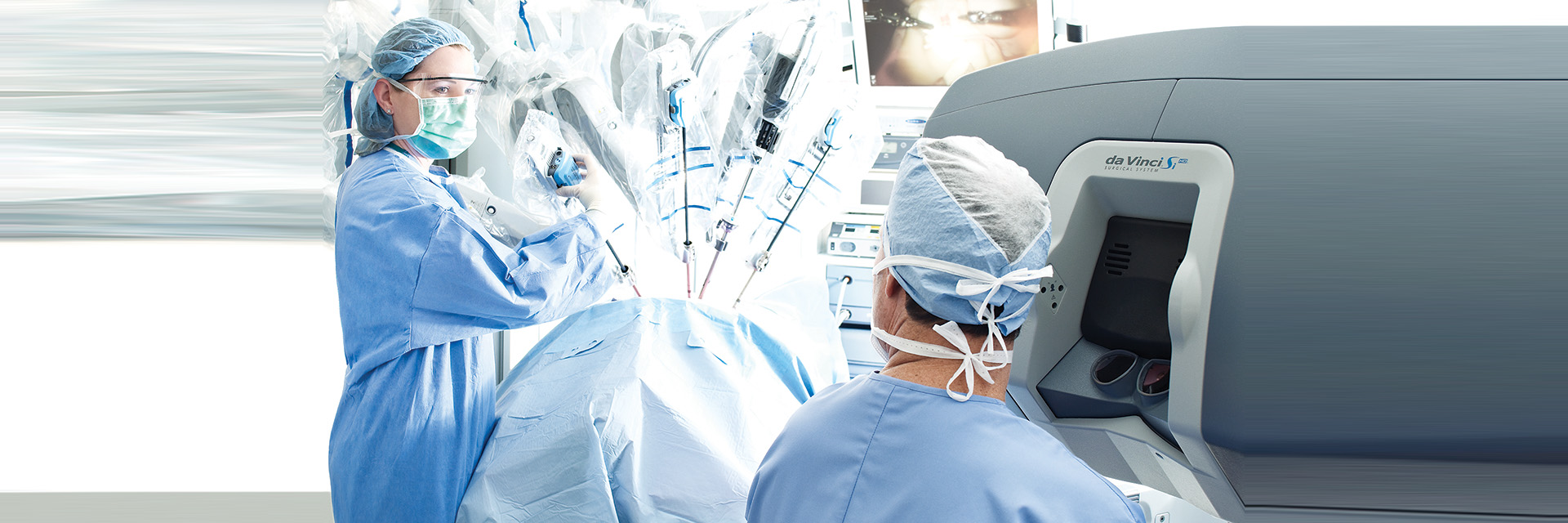Robotic surgery allows doctors to perform many complex procedures with more precision, a greater range of motion, flexibility, and control than is possible with conventional techniques.
The FDA approved the da Vinci Surgical System for robotic surgery for gynecologic cases in 2005. The system includes three main components:
- Surgeon’s Console. The surgeon’s console is where your surgeon sits during the procedure, has a close-up 3D view of your anatomy and controls the instruments. The instruments are “wristed” and move like a human hand, but with a far greater range of motion.
- Patient-Side Cart. The patient-side cart is positioned near the patient on the operating table. It is where the instruments used during the operation move in real-time in response to your surgeon’s hand movements at the surgeon console.
- 3D Vision System. The vision cart makes communication between the components of the system possible and supports the latest 3D high-definition vision system.
The da Vinci Surgical System was originally approved for robotic-assisted laparoscopic benign gynecological procedures like a myomectomy (fibroid removal), hysterectomy, endometriosis, tubal anastomosis (tubal sterilization reversal), and sacrocolpopexy.
Over the years, robotic surgery using the da Vinci System has been gaining ground as an alternative to open method and complimenting laparoscopic surgery, because of its safety and efficacy. Today, applications of robotics in gynecology has expanded to include other procedures, some of which include an oophorectomy, ovarian cystectomy (removal of a cyst from an ovary), resection of endometriosis, and lymphadenectomy (lymph node dissection) with an increasing role of robotic surgery in gynecological oncology. It has also shown to be effective in repairing genitourinary injuries that occurred in previous gynecological surgeries.
-
What is the purpose of robotic surgery?
Robotic surgery allows doctors to perform many complex procedures with more precision, a greater range of motion, flexibility, and control than is possible with conventional techniques.
-
What are the advantages of robotic surgery?
The advantages of robotic surgery are similar to those of minimally invasive surgery, which include smaller incision sites, lower morbidity rates, less postoperative pain, decreased risk of infection, less blood loss, fewer complications, less scarring, and shorter hospital stays.
-
What is minimally invasive surgery?
Minimally invasive surgery allows your surgeon to use specific surgical techniques that limit the size and number of incisions that need to be made during a surgical procedure. As a result, your surgeon can perform surgery without cutting into a lot of skin and muscle.
-
How is robotic surgery better for complex surgeries?
Robotic surgery gives an edge to more complex surgeries because of robotic assistance. As a result, the conversion rate to open surgery is lesser as compared to laparoscopy. This is due to the Endo wrist movement of robotic instruments, allowing for better and precise suturing than conventional straight stick laparoscopy.
-
How is robotic surgery performed?
In using state-of-the-art technology, the da Vinci System requires only a few tiny incisions, and your doctor is able to operate with enhanced vision, precision, dexterity, and control. With da Vinci’s 3D, high-definition vision system, your surgeon can see key anatomy with immense depth and clarity–critical for complex conditions.
-
Does insurance cover robotic surgery?
Robotic surgery is categorized as robot-assisted minimally invasive surgery, so any insurance company that covers minimally invasive surgery should cover robotic surgery. You should, however, double-check with your insurance provider before scheduling a procedure.
-
What is recovery like after robotic surgery?
With robotic surgery, your return to normal activities can occur in as little as 2 to 3 weeks.
For more information on robotic surgery or to schedule a consult, please call us at 214-363-4421.
This information is provided for informational educational purposes only, and should not be considered as individual medical advice. Please discuss your specific situation with your medical provider.

